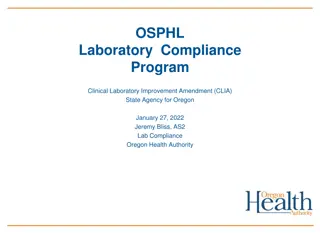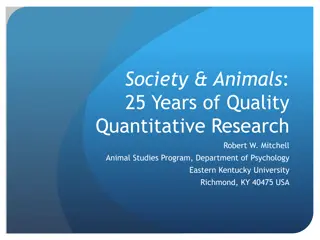Laboratory Animal Testing in Science
Laboratory animal testing, also known as animal experimentation, involves using non-human animals in experiments to control variables affecting biological systems. Different species like mice, rats, rabbits, cats, dogs, and primates are utilized for research in various fields such as pharmacology, virology, and disease modeling. This practice is justified by its potential to increase knowledge, species understanding, and benefits to human and animal health.
Download Presentation

Please find below an Image/Link to download the presentation.
The content on the website is provided AS IS for your information and personal use only. It may not be sold, licensed, or shared on other websites without obtaining consent from the author.If you encounter any issues during the download, it is possible that the publisher has removed the file from their server.
You are allowed to download the files provided on this website for personal or commercial use, subject to the condition that they are used lawfully. All files are the property of their respective owners.
The content on the website is provided AS IS for your information and personal use only. It may not be sold, licensed, or shared on other websites without obtaining consent from the author.
E N D
Presentation Transcript
AL-Mustansiriyah University College of science Biology Dept. Zoology 4thclass Laboratory Technique LAB. (7) NAME :
ANIMAL LABORATORY ANIMAL TESTING, ALSO KNOWN AS ANIMAL EXPERIMENTATION, ANIMAL RESEARCH AND IN VIVO TESTING, IS THE USE OF NON-HUMAN ANIMALS IN EXPERIMENTS THAT SEEK TO CONTROL THE VARIABLES THAT AFFECT THE BEHAVIOR OR BIOLOGICAL SYSTEM UNDER STUDY.
The most important species of laboratory animals MOUSE MOST FREQUENTLY USED. PPHARMACOLOGY, GENETICS OF MAMMALS, VIROLOGY, MODELS OF HUMAN DISEASES (MUTANT STRAINS, TRANSGENIC AND KNOCK- OUT MICE) RAT PHYSIOLOGY OF COGNITIVE PROCESSES, BEHAVIOUR, MODELS OF DIABETES RABBIT SEROLOGY, INSULIN QUANTIFICATION, PYROGENS QUANTIFICATION, TESTS OF IRRITABLE EFFECT OF CHEMICAL SUBSTANCES ON THE CORNEA CAT STUDY OF CNS AND RESPIRATORY SYSTEM DOG USE IN ELECTROPHYSIOLOGY, NEUROPHYSIOLOGY GUINEA-PIG IN MICROBIOLOGY AND SEROLOGY, PHYSIOLOGY OF THE AUDITORY SYSTEM HAMSTER - GENETICS PIG TRAINING OF SURGICAL TECHNIQUES, TEMPORARY COVERING OF BURNS WITH PORCINE SKIN PRIMATES RHESUS MONKEY, BABOON, CHIMPANZEE USE IN NEUROLOGY, VIROLOGY, BEHAVIOUR FROG PHYSIOLOGY OF BLOOD CIRCULATION, ELECTROPHYSIOLOGY FISH,INSECTS... 3
EXAMPLES OF USE IN RESEARCH: 1. 2. 3. 4. 5. 6. 7. CANCER DOWN SYNDROME DIABETES LEUKEMIA ALLERGIES RESPIRATORY DISEASES NUTRITIONAL RESEARCH
Overview Some people are troubled by the use of animals in research. Each individual must make decisions about the kind of research he/she wishes to perform.
Justification for using animals Q. Why is this the right animal model? A. Research should be undertaken with a clear scientific purpose. B. There should be a reasonable expectation that the research will: 1. Increase knowledge of the processes underlying the evolution, development, maintenance, alteration, control, or biological significance of behavior 2. Increase understanding of the species under study 3. Provide results that benefit the health or welfare of humans or other animals.
Transportation Issues I. Proper packaging II. Timely shipping III. Appropriate care upon arrival Once the animals arrive: Adequate Veterinary Care Consultation with the principal investigator to minimize pain and distress.
Housing Standards I. Heating, cooling, and temperature II. Ventilation III. Compatible groupings IV. Exercise V. Food and water VI. Psychological well-being
Disposal The return of wild-caught animals to the field can carry substantial risks To the formerly captive animals and to the ecosystem. Animals reared in the laboratory should not be released In most cases, they cannot survive or they may survive by disrupting the natural ecology. Proper (humane) euthanasia

 undefined
undefined































